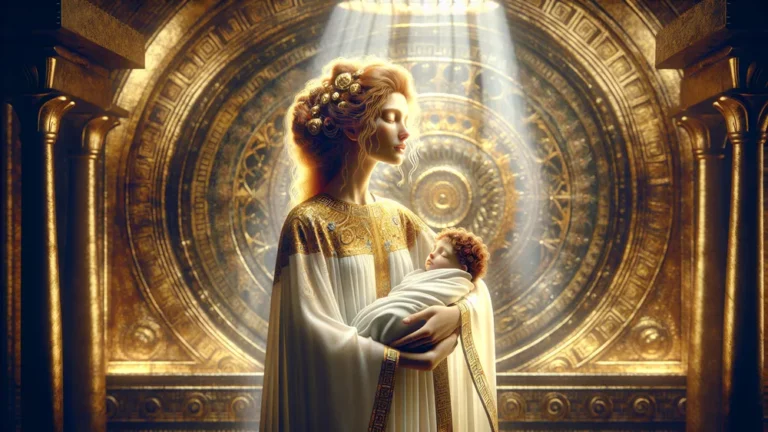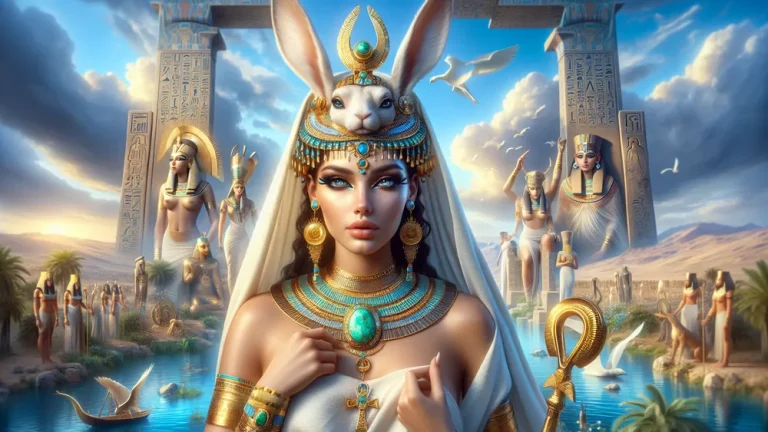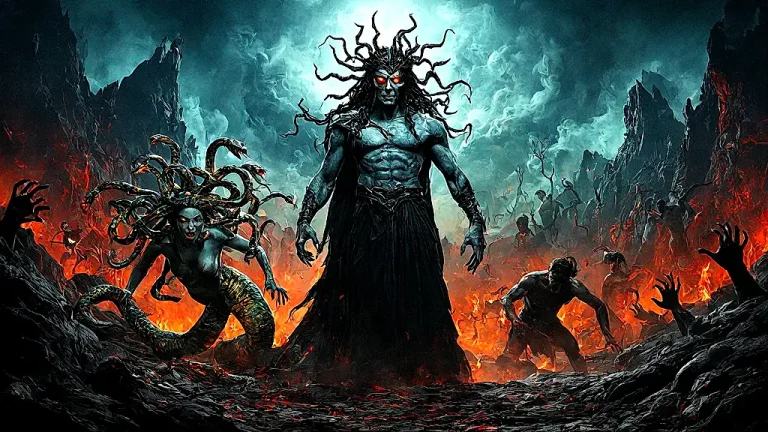Ancient Egyptian Goddess Isis: History And Facts
Isis is one of the most venerated deities in ancient Egyptian mythology. She holds a special place in the pantheon of gods and goddesses. People revere her as a goddess of magic, wisdom, motherhood, and protection. Her influence goes way beyond Egypt, touching various cultures throughout history. This blog post dives into her origins, roles, attributes, and widespread veneration.
Key Points:
- Isis is a prominent ancient Egyptian goddess known for magic, wisdom, and motherhood.
- Her name Isis originates from the Egyptian word for throne, symbolizing her royal and protective roles.
- Isis is the daughter of Geb and Nut and a central figure in the Ennead of Heliopolis.
- She is recognized for resurrect Osiris, protect Horus, and safeguard the dead in the afterlife.
- Isis is worshipped through rituals, festivals, and personal devotion by ancient Egyptians and later by Greeks and Romans.
- Her symbols include the throne-shaped crown, cow horns with a sun disk, ankh, and scepter.
- Temples dedicated to Isis, like the Temple of Philae, and her influence on other cultures, particularly the Greeks and Romans, showcase her widespread veneration and impact.
We aim to give you a full picture of her importance in ancient Egyptian religion and her lasting legacy. We will explore many aspects of Isis, from her mythological beginnings to her impact on later civilizations.
The Origins of Isis
To get a grip on who Isis really is, we gotta look at where she comes from and how she first pops up in ancient Egyptian stories. So, let’s dive into the meaning of her name and her early roles in those myths.
Name and Meaning
The name “Isis” comes from the ancient Egyptian word “Aset” or “Iset,” which means “throne” or “seat.” This is pretty important because it shows her role as a big deal in the Egyptian gods’ world. In ancient Egypt, a throne isn’t just a chair; it’s a symbol of royal power and divine authority. So, her name really ties her to kingship and being a protector of the pharaohs.
Plus, her name also hints at her being a mother figure since she’s often shown as the mom of Horus, the god with a falcon head who stands for kingship and the sky.

- Aset/Iset: Ancient Egyptian terms for “throne” or “seat.”
- Symbol of Royal Authority: Her name signifies her connection to kingship.
- Mother of Horus: Reflects her role as a nurturing and protective mother figure.
- Protector of Pharaohs: Her name indicates her protective role over the rulers of Egypt.
Isis’s name Aset or Iset comes from ancient Egyptian for throne or seat, revealing her association with royal power and motherly protection, which ties her closely to kingship and guardianship of pharaohs and Horus.
Mythological Beginnings
Isis first shows up in Egyptian mythology as part of the Ennead of Heliopolis. This group of nine gods is super important in ancient Egypt. She’s the daughter of Geb, the earth god, and Nut, the sky goddess. So, she’s got some pretty powerful siblings: Osiris, Set, and Nephthys. Her story really kicks off with her brother and husband, Osiris.
In the Osiris myth, Isis is this super devoted wife who uses her magical abilities to bring Osiris back to life after Set kills him. This story shows off her resilience and loyalty big time. Early on, you see Isis in art as a woman with a throne-shaped crown. This symbolizes her name and her role as a protector of pharaohs.
Sometimes, she’s got these cow horns with a sun disk between them, which links her to Hathor, another big-time goddess. Her stories often show how smart and resourceful she is. Like that time she tricks the sun god Ra into revealing his secret name to gain power.
These early tales set her up for later as a major figure in Egyptian religion and culture.
- Ennead of Heliopolis: Group of nine deities including Isis.
- Daughter of Geb and Nut: Establishes her divine lineage.
- Throne-shaped Crown: Symbolizes her protective role over pharaohs.
- Cow Horns with Sun Disk: Links her to Hathor and emphasizes her divine status.
- Resurrection of Osiris: Demonstrates her magical abilities and loyalty.
- Tricking Ra: Showcases her intelligence and cunning nature.
Roles and Attributes of Isis
So, now that we know where Isis comes from and how she first shows up in myths, let’s talk about what she actually does. She’s got a lot going on, and it’s super interesting to see all the different roles she plays.
Goddess of Magic and Wisdom
Isis, she’s all about magic and wisdom in ancient Egyptian tales. People see her as this super powerful sorceress with deep knowledge. One story shows her bringing her husband Osiris back to life after Set kills him. She uses her amazing magical skills to find his body parts and performs rituals to revive him, even if it’s just for a bit. Another cool story?

She makes a magical snake bite the sun god Ra, forcing him to tell her his secret name, which gives her huge power and knowledge. These stories really show how she masters magic and uses it to make big things happen, making her a figure of both intellectual and supernatural strength.
- Isis often holds a scepter and an ankh, symbols of power and life.
- She’s seen as the inventor of agriculture and medicine, showing her wisdom.
- In the “Hymn to Isis,” people praise her for knowing the heavens and earth.
- Her magic also protects the dead, ensuring they safely reach the afterlife.
Isis is a powerful figure in ancient Egyptian tales, known for her mastery of magic and wisdom which she uses to bring about remarkable events and protect the dead.
Mother Goddess
In ancient Egyptian mythology, Isis is this amazing mother figure. She’s all about nurturing and protecting. Her story with her son, Horus, really shows this. After Osiris, her husband, dies, she gives birth to Horus and hides him from Set, who’s out to get him. She’s super dedicated to Horus.

You see it in so many myths where she uses her magic and wisdom to keep him safe and make sure he grows up strong. This bond between them is huge. It’s not just about Horus; it shows how Isis is seen as a protector and nurturer by everyone who worships her.
- Isis often shows up in art breastfeeding Horus, which is a big symbol of her as a nurturing mom.
- She’s seen as a protector of kids and moms in ancient Egypt.
- In the story of “Horus and Seth,” her clever tricks help Horus get his throne back.
- Her story is all about resilience, protection, and that special motherly love.
Protector of the Dead
Isis is a big deal when it comes to protecting the dead in ancient Egyptian mythology. She’s all about those funerary practices and rituals, making sure souls get to the afterlife safely. You see her magic in action in the story of Osiris, where she brings him back to life. This shows rebirth and eternal life.
You often find her in tombs and funerary texts like the Book of the Dead, helping out the deceased. She’s like a guardian, using her magic to keep evil spirits away and making sure the dead get judged fairly. Her role in these rituals really shows how important she is in balancing life and death. She’s a key figure in what ancient Egyptians believed about the afterlife.
| Role | Description | Examples |
|---|---|---|
| Resurrection | Uses magic to bring Osiris back to life | Story of Osiris |
| Protection | Guards the deceased from evil spirits | Depictions in tombs |
| Guidance | Assists souls in navigating the afterlife | Book of the Dead |
| Judgment | Ensures fair judgment of souls | Funerary texts and rituals |
Iconography and Symbols
So, when we look at the visual side of Isis, it really helps us get why she’s so important in ancient Egyptian culture. Let’s dive into how she shows up in art and the different symbols that are tied to her.
Depictions in Art
In ancient Egyptian art, you often see Isis as a woman in a long sheath dress with a throne-shaped crown on her head. This crown symbolizes her name, which means “throne.” She usually has a pair of cow horns with a sun disk between them, linking her to Hathor, another important goddess.
Isis is frequently illustrated holding an ankh, the symbol of life, and a scepter, showing power and authority. You also see her with outstretched wings a lot, which means she’s a protective deity. These wings often wrap around the deceased, showing her role in funerary practices. Plus, she’s sometimes shown breastfeeding her son Horus, highlighting her as a nurturing mother goddess.
- Throne-shaped crown: Represents her name and authority.
- Cow horns with sun disk: Links her to Hathor and celestial aspects.
- Ankh and scepter: Symbols of life and power.
- Outstretched wings: Signify protection and funerary roles.
- Breastfeeding Horus: Emphasizes her nurturing and maternal qualities.
Temples and Statues
There are quite a few temples dedicated to Isis scattered around ancient Egypt. The Temple of Philae is probably the most famous one. It sits on an island in the Nile River and is known for its beautiful architecture and detailed reliefs that tell stories about Isis. Then there’s the Temple of Behbeit el-Hagar in the Nile Delta.
It’s mostly in ruins now, but it used to be a grand place dedicated to her. You can also find notable statues of Isis in the Temple of Karnak. These statues often show her with other gods, which shows how important she is in the Egyptian pantheon.
Most of these statues show her sitting down, holding symbols like the ankh and scepter, which highlight her roles as a life-giver and powerful goddess. And let’s not forget the Isis Lactans statues. These ones show her nursing Horus and are found all over Egypt, symbolizing fertility and motherhood.
- Temple of Philae: Known for its architectural beauty and mythological reliefs.
- Temple of Behbeit el-Hagar: Once a grand structure in the Nile Delta.
- Statues in the Temple of Karnak: Depicting Isis with other deities.
- Isis Lactans statues: Representing her as a nurturing mother.
Isis was worshipped in various temples across ancient Egypt, with the Temple of Philae standing out for its beauty and the Temple of Karnak for its statues portraying her with other gods.
Worship and Influence
Isis’s importance goes beyond just myths and art. She really touches the everyday lives and spiritual practices of ancient Egyptians. So, let’s dive into how they venerated her and see her impact on other cultures.
Popular Worship Practices
So, how did the ancient Egyptians worship Isis? Well, they had a bunch of ways that were part of their everyday life and special ceremonies. Priests play a big role in this. They take care of her temples, do rituals, and offer prayers to keep her happy and protective. These priests do daily rites, which means they give food, drink, and incense to her.

And then there are the festivals. These are huge events with processions, music, and dance. One of the big ones is the “Feast of Lights,” where everyone lights lamps to honor her. People also show personal devotion. Many keep small statues or amulets of Isis at home for protection and blessings.
- Daily Rites: Priests give food, drink, and incense.
- Feast of Lights: A big festival with lamps.
- Personal Devotion: Small statues or amulets at home.
- Elaborate Processions: Music and dance during festivals.
Influence on Other Cultures
Isis’s worship spreads way beyond Egypt. The Greeks start to venerate her after Alexander the Great conquers Egypt. They love her because she’s a goddess of magic, motherhood, and protection. You can find temples dedicated to her in places like Athens and Delos. Then, the Romans pick up on it too.
They bring her into their pantheon, seeing her as a goddess who offers personal salvation and protection. During the Roman Empire, her cult becomes super popular. Temples called Isea pop up everywhere, from Pompeii to London. Even Roman emperors like Augustus and Caligula join in her rites, which really cements her status.
Her symbols, like the sistrum (a musical instrument) and the knot of Isis (a protective amulet), get widely adopted and adapted in these cultures.
- Greek Temples: Established in cities like Athens and Delos.
- Roman Isea: Temples found across the Roman Empire.
- Sistrum: A musical instrument associated with Isis.
- Knot of Isis: A protective amulet widely used.
Isis’s worship expands to the Greeks and Romans, influencing their cultures and leading to the widespread establishment of temples and adoption of her symbols.
Pantheon of Egyptian Gods
The pantheon of Egyptian gods? It’s huge and pretty complex. There are deities for almost everything in life and the universe. If you want to dive deep, check out this list of all the Egyptian gods. It gives you the lowdown on each god’s role, what they’re about, and why they matter in ancient Egyptian culture.
FAQs
1. Who were the parents of Isis?
So, Isis’s parents? They’re Geb, the earth god, and Nut, the sky goddess.
2. What are the main symbols associated with Isis?
So, the main symbols you see with Isis are the throne hieroglyph, the ankh, and the tyet.
3. How did Isis influence later religions?
Isis’s influence on later religions is pretty fascinating. She brings her magic and motherhood vibes into Greek and Roman traditions. They venerate her as a goddess, and you can see her attributes and worship practices blending in.
4. What are some famous myths involving Isis?
There are quite a few famous myths about Isis. One big story is how she resurrects Osiris. Another one is about her protecting her son Horus from Set.







